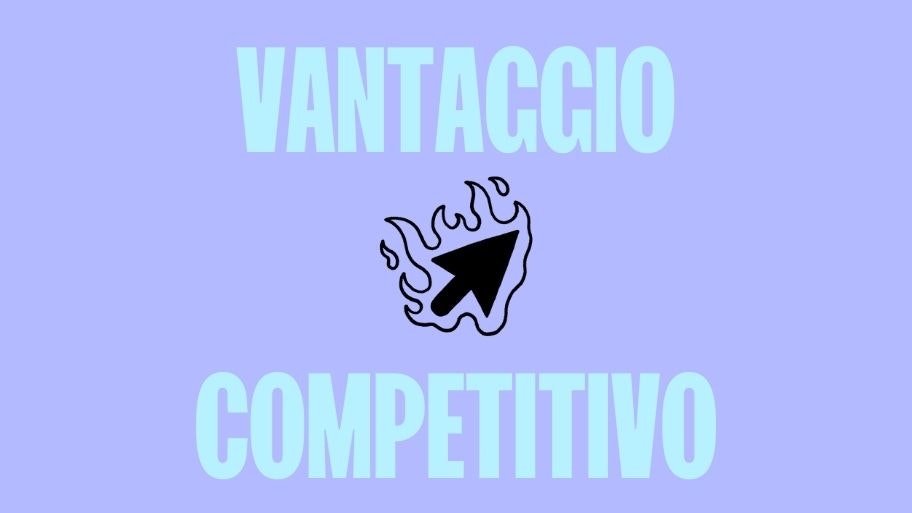Anyone who’s started a business (or is even thinking about starting one) has put some thought into their competition and how that impacts their chances of success.
After all, you need to understand what you’re up against to make sure you have the resources and strategy to keep up.
That’s where competitive advantage comes in.
But what is competitive advantage? In a nutshell, it’s a broad business theory that helps keep companies afloat against all the other companies in their industry and niche.
In this article, we’ll define competitive advantage and why it’s important, discuss some types of competitive advantage, and discuss how you can achieve it for your own business.
Shall we begin?



What Is Competitive Advantage?
Before we dig into how you secure a competitive edge and what those strategies might look like, let’s define competitive advantage.
Competitive advantage is a blanket term that describes proven approaches to beating out your competition.
→ Click Here to Launch Your Online Business with Shopify
The term hit the mainstream in 1985, when Harvard University graduate Michael Porter published a book aptly titled “Competitive Advantage.”
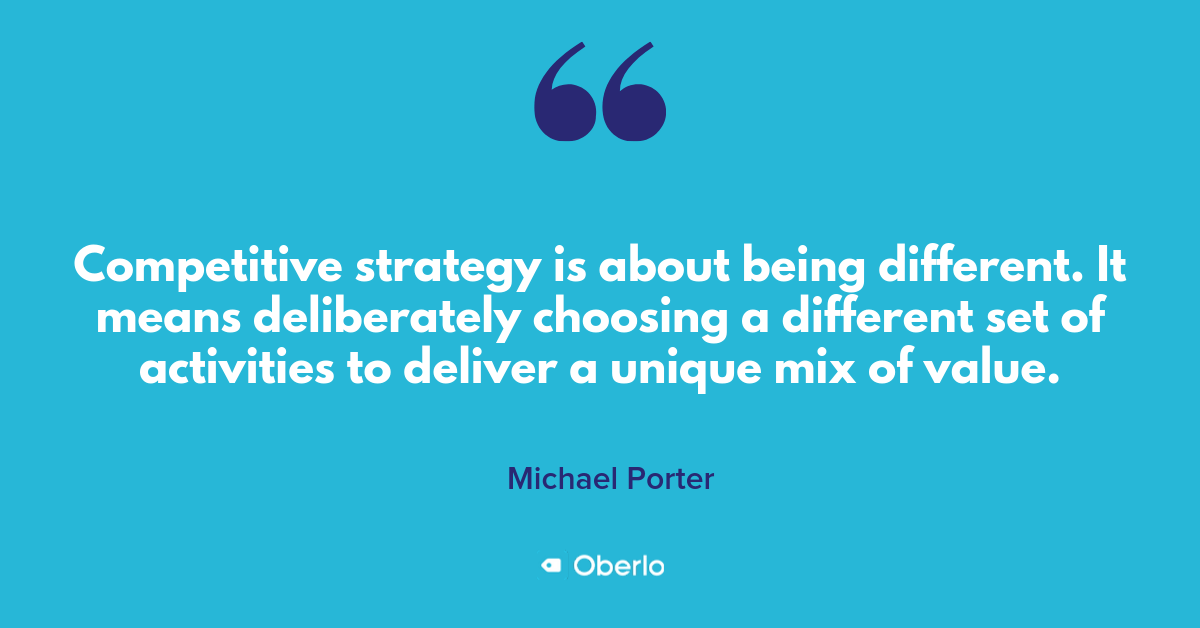
In the book, he discussed two main ways to gain a competitive advantage: lowering your cost and differentiating your offering from competitors (which we’ll get into shortly).
Interestingly, the theory of competitive advantage can apply virtually anywhere. For example, countries can use the theory to be economically competitive against other countries, and individuals can use it for personal or professional gain.
But for the rest of this article, we’ll assume that you’re not here because you’re looking for advice on how to run a country.
We’ll stick with how to gain competitive advantage for a business, specifically an online business like a dropshipping store.
What Is Competitive Strategy?
If you think of competitive advantage as the research and observation process for how you can improve your business, competitive strategy is the plan you use to get there.
Your competitive strategy can look however you want it to, but it’s generally the type of long-term plan that shows you’re “in it to win it.”
To be truly effective, a competitive strategy starts foundationally by guiding your core business model.
It carves out key decisions, like:
- The cost of your products or services
- Your company’s brand strategy and positioning in the market
- The nature of your customer service and their overall experience
- The marketing strategies and channels you’ll use to promote yourself
- Potential partnerships with other brands
Of course, you can adapt this as needed throughout the lifetime of your business. But it sure helps to figure out your key competitive advantages – and disadvantages – earlier rather than later.
This way, you have more leeway to adopt competitive strategies, while minimizing the need to backtrack or change your existing company identity or operations.
Why Is Competitive Advantage Important?
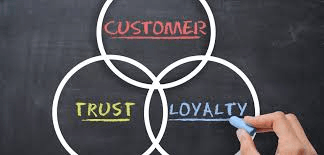
The answer to this question could go on for years. It’s like answering the question, “Why is a profitable business important?”
When you observe this strategy, you’re essentially working to set your company up for success.
In doing so, you can reap the endless benefits of competitive advantage, such as:
- More customers: A good competitive advantage makes your company more desirable than your competitors. This means that more customers will choose you over them. And who doesn’t want more customers?
- More loyalty: There are a lot of ways to achieve brand loyalty, which is when a customer makes a long-term commitment to choose your brand over competitors. When done right, your competitive strategy will help to build this loyalty.
- More revenue: This is a natural extension of having more customers – especially more loyal customers. When you can keep a high customer lifetime value, you’re ensuring that you can bring in more revenue for less marketing dollars spent on getting new customers.
Now that you have an idea of what competitive advantage is, let’s look at the types of competitive strategy.
Types of Competitive Strategies
Like I mentioned earlier, Michael Porter’s competitive advantage model uses two main approaches:
- Lower cost: Simply put, this is achieved by selling your products or services for cheaper than competitors. This is a surefire way to snatch customers from competitors, though it doesn’t necessarily help to build coveted brand loyalty.
- Differentiation: This is achieved by standing out in some way, whether that’s a unique offering or feature, exceptional customer experience, added value, or the like. This unique element is what attracts and keeps customers, and is more likely to build loyalty in the long run.
Pro tip: I recommend being careful when working on a lower cost model. It’s easy to find yourself in the infamous “race to the bottom,” where you and your competitors keep lowering prices until nothing’s profitable anymore. That’s a sad way to go out.
Going deeper into Porter’s model, cost and differentiation strategies can be looked at based on the scope of the business: a broad scope that caters to bigger industries, groups, and segments, or a niche scope with a more narrow playing field.
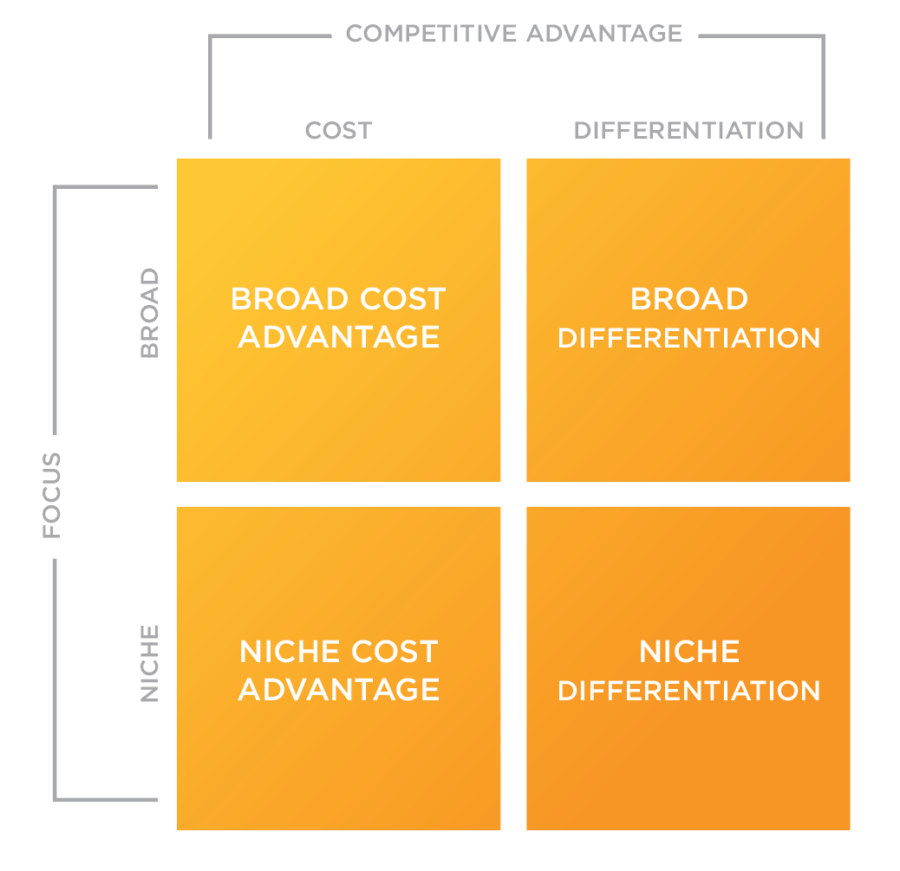
Let’s quickly look at these four:
Broad cost advantage. Think Amazon, Costco, or Walmart. Companies with a broad cost advantage are catering to a large target audience by producing or acquiring their products in bulk for low prices, and often outsourcing to keep their operational costs low.
Generally speaking, a small business can’t keep up with these brands – which is why going niche is a more sustainable competitive advantage.
Niche cost advantage. These companies are still operating on a low-cost strategy, but they’re catering to a much smaller segment (or niche) of the market. For example, instead of selling any and all types of jewelry, you sell a specific type of antique jewelry that a small subset of jewelry-wearers want.
Since it’s more specific, you only need to price your items based on other niche competitors, instead of the lower costs of the general market. This means a niche cost advantage can lead to higher profit margins.
Broad differentiation. This broad-scope approach is when larger brands with larger audiences enhance their offering in some way. Consider a brand like Starbucks. It caters to a massive population around the world, and has earned a strong reputation by focusing on the quality and fast personalization of its products.
The company has profoundly impacted the way that we drink and enjoy coffee, and that’s paid off – it earned nearly $25 million in revenue in 2018.
Niche differentiation. If you’re a small business owner, this is likely your best bet for establishing and growing a strong brand. When you narrow the playing field by pursuing a more specific niche, you have more opportunities to understand your customer.
Ultimately, this translates into better opportunities to build value and loyalty.
Which brings us to the next section: a handful of ideas to get you started on your competitive advantage. You’ll find that several of these are niche differentiation strategies.
How to Gain Competitive Advantage: 7 Ideas
Strong competitive advantage strategies come in all shapes and sizes. Here are seven ideas to get your gears turning.
- Decrease Your Overhead Costs
If you’re interested in competing on cost, it’s critical that your own operational costs are as low as possible. This way, you can afford to sell at lower rates without cannibalizing your own profits.
In the ecommerce arena, starting a dropshipping store can be a great solution. In this business model, you don’t have to manage your own inventory – which means you don’t need to worry about stock, a warehouse, or shipping items yourself.
Dropshipping can have incredibly low overhead, which allows you to swoop into your market and stack up customers.
If you’re interested in learning more about the dropshipping business model, check out our video:
- Specialize Your Niche
As we discussed above, niches can be a golden ticket to a sustainable competitive advantage.
Simply put: the more specialized your offering is, the more value it has. And the more value it has, the more customers are willing to pay for it.
Consider something hyper-specific – like nail polish for dogs.
There isn’t a huge market for this, but this fact can double as the gateway to your competitive advantage.
This might allow for much clearer – and thus more effective – brand positioning and audience targeting, which makes it easier to communicate your brand’s value and win over more customers.
- Build a Luxury (or at Least More Luxurious) Brand
On the flip side, you might find that it’s not a sustainable competitive advantage to compete on price alone.
You can avoid this dilemma by building a stronger or more “luxurious” brand. Countless research shows that customers are more willing to pay a premium price to shop with a strong brand.
If you can build a quality brand image that customers trust and love, you won’t need to worry about offering the lowest price in your niche.
Want to learn more about building a more appealing brand? Check out our article: The Ultimate Guide to Brand Image.
Here’s a video that discusses how to brand in a dropshipping context:
- Provide Incredible Customer Experiences
Unless your prices are astoundingly low, it’s easy to push customers away with sub-par experiences.
Data shows that now, more than ever, customers are demanding positive experiences with brands – or they’ll happily take their business elsewhere.
One study shows that 86% of buyers will pay more for great experiences and 73% say that customer experiences influence their purchasing decisions.
A good customer experience takes a lot of elements into account, like:
- Fast, responsive, and helpful customer service
- Value-adds like free shipping or returns
- Perks and freebies to show your appreciation for customers
- Increased convenience in comparison to competitors
- Use of new tech or unique processes to improve the status quo
- Delivering on Every. Single. Promise.
- Surprise and Delight Your Customers
You might be familiar with the term “surprise and delight,” which is an old marketing term that’s made its way around the block a few times.
This is the act of going out of your way to literally surprise and delight your customers. At the end of the day, this is a fantastic competitive advantage strategy, given how simple it can be to execute.
Consider the accounting software FreshBooks. They sent a cookie cake to celebrate a customer’s 10th anniversary.
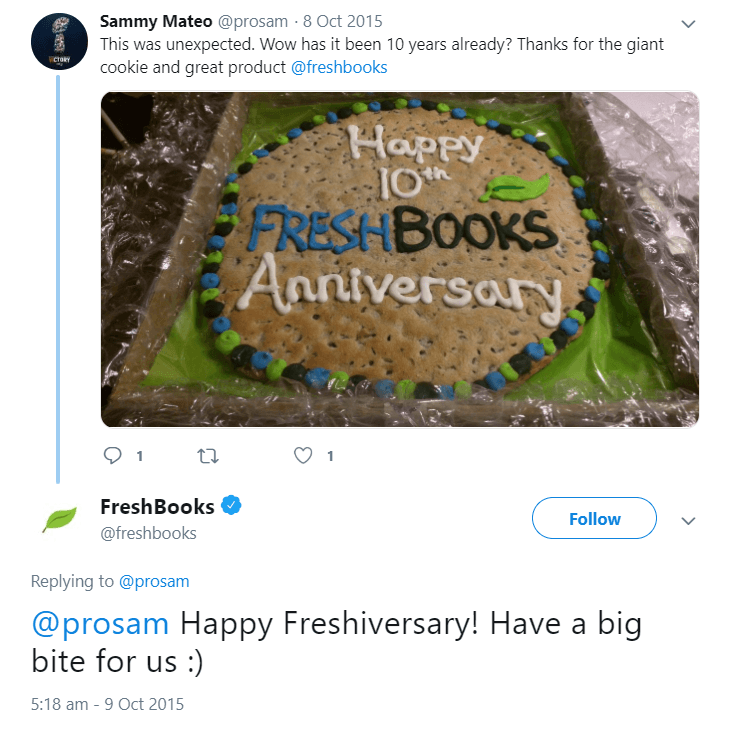
As a bonus, their customer tweeted their delightful surprise, which is essentially free marketing.
FreshBooks nailed it.
- Create Exceptional Content
You know the old saying, “content is king.”
Just because it’s old doesn’t mean it’s outdated.
According to Nielsen, American adults spend a jaw-dropping 11 hours a day watching, reading, listening to, or generally interacting with various types of media.
That’s a whole lot of opportunities to engage your prospects and customers through things like:
- Videos
- Blogs
- Webinars
- Ebooks
- Infographics
- How-to guides
- Podcasts
In fact, content is how a lot of brands are able to differentiate themselves from others and build a strong following.
That’s how we’re engaging you right now! Pretty meta, eh?
To learn more about creating awesome content, check out our article about how to create a content strategy to increase traffic to your website.
- Use Partnerships to Boost Your Capabilities and Reach
Picture this scenario: you have an ecommerce store that manufactures and sells outdoor hobby items.
After a year of business and gathering market feedback, you realize that your compression leggings could be more successful if they had a bit more insulation.
But producing these leggings will be too pricey with your current manufacturing capabilities, which would cut into your profits.
So you partner with a company that can do it more affordably – a win-win for you and your partner.
Partnering can manifest in several ways, from production to marketing. For example, influencer marketing is a type of partnership that gets you quick access to an influencer’s loyal audience.
Instagram is a huge channel for this.
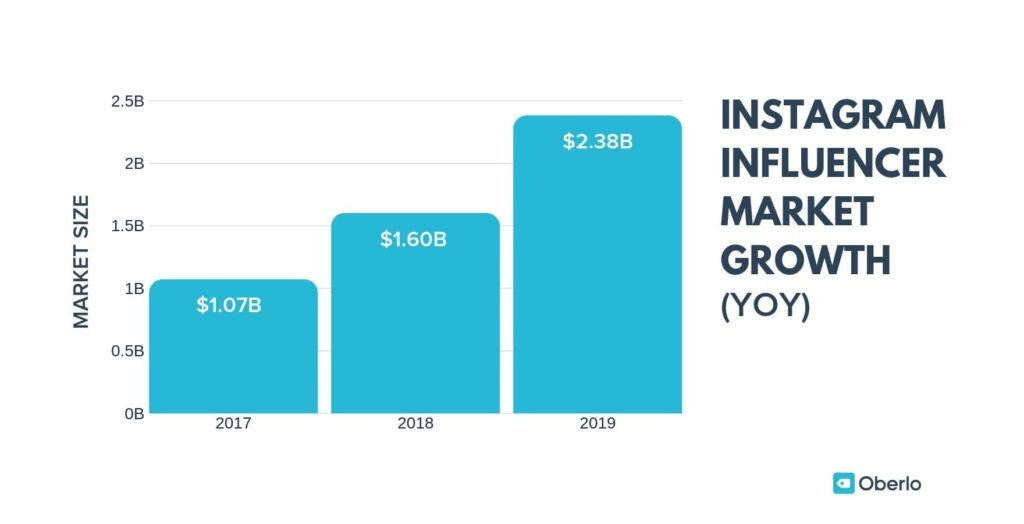
Finding Your Competitive Edge
When it comes to learning how to create a competitive advantage, the options are infinite. That’s why it’s important to take a strategic, purposeful, and well-researched approach.
This way, you can ensure that you’re considering all the possibilities while avoiding the issues that can occur if you move too quickly without considering all the repercussions.
While today’s shopper finds cost to be important, I strongly recommend that you work on differentiating your brand with unique features, benefits, and offerings.
You don’t have much control over market prices, but you do have control over the experiences you can create for your customers. Use these experiences to keep them coming back.
What’s your competitive advantage strategy? Drop us a comment below!



